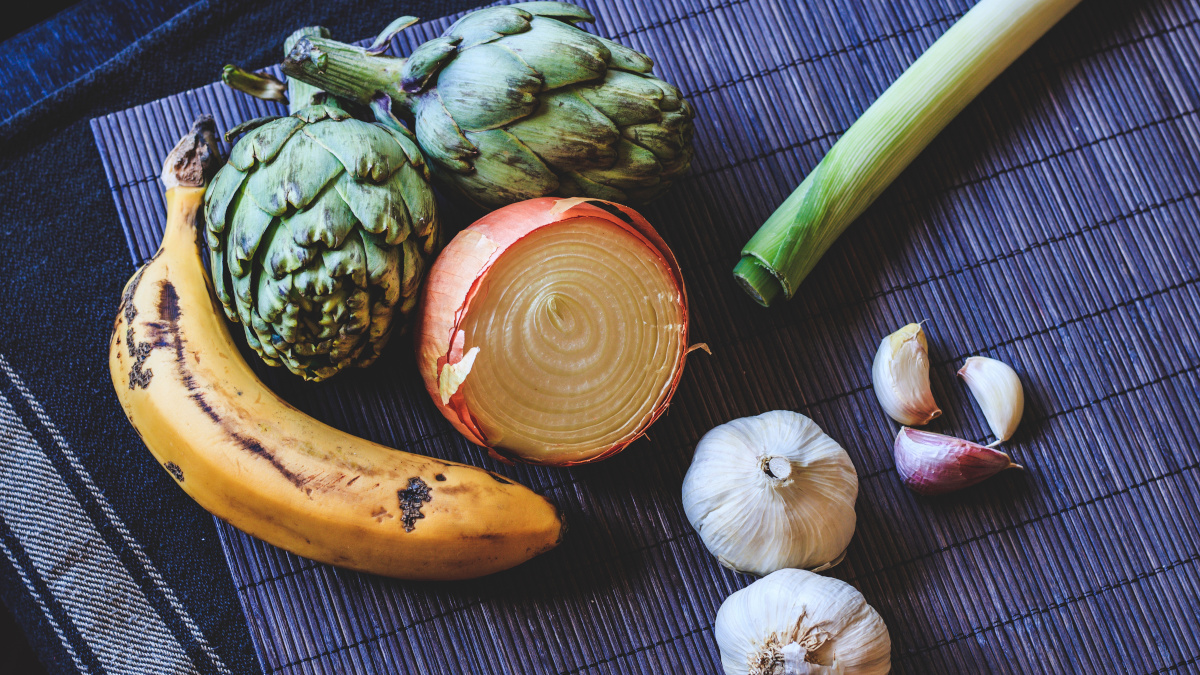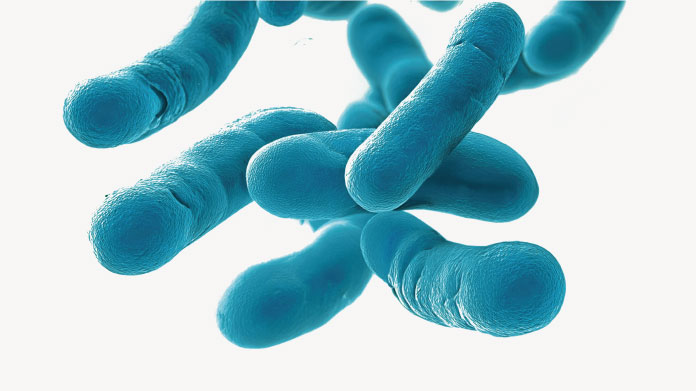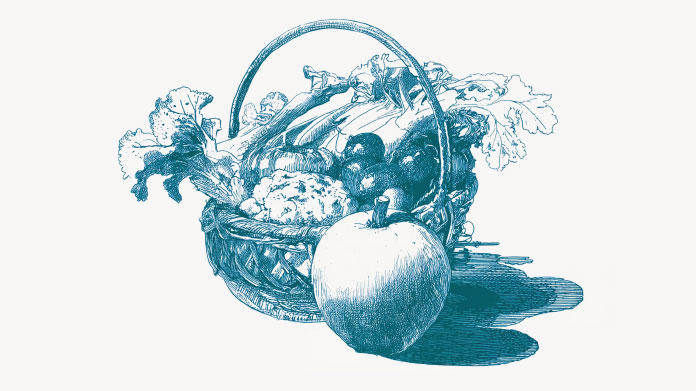Fructooligosaccharides: What are they? Why should you take them?
Perhaps you’ve heard of fructooligosaccharides (FOS) but don’t know much about them? Read on to discover the virtues of this little-known but highly beneficial source of fibre.

Fructooligosaccharides: a specific type of fibre
Also known as oligofructose, fructooligosaccharides are primarily classified as a source of dietary fibre.
Exclusive to the plant kingdom, they are largely composed of complex carbohydrates (polysaccharides) the chemical structure of which impedes activation of digestive enzymes. As a result, they are neither hydrolyzed (metabolised) nor absorbed by the body (1).
Although dietary fibre has no nutritional value, it works in various ways to help regulate digestive balance. There are two forms, each with its own specific properties (2):
- soluble fibre, which dissolves in water, lines the gut walls with a viscous gel which causes the stomach to empty more slowly and effectively produces a feeling of prolonged fullness (3). Very gentle on the gut, this kind of fibre includes types of gum, mucilage, and pectin, as well as the subject of this article, FOS.
- insoluble fibre, which does not dissolve in water, bulks out stools by increasing their volume and acts mechanically to facilitate the mechanism of defecation. However, it’s thought to be more irritating to sensitive guts (4). This kind of fibre includes cellulose, hemicellulose and lignin.
Some types of fibre, though not all, are also fermented in the large intestine. In fact, the way they interact with gut flora (the microbiota) is attracting significant interest among the scientific community (5).
With its complementary and versatile nature, dietary fibre has a direct effect in helping to maintain good general health (6). A daily intake of 25g-30g is thus recommended by one European health safety agency (7), though dietary behavior studies suggest many Europeans (French, Danes, Italians and Czechs) actually consume less than 20g a day (8).
What’s specific about FOS?
Composed of linear chains of fructose units (from 2 to 60) often terminating in a glucose unit, FOS are in some ways similar to sucrose: like table sugar, they actually have a naturally sweet taste, though they have only half the calories (just 2 kcal/g).
Taking on all the advantages of soluble fibre, fructooligosaccharides also offer a prebiotic action (9). As fermentable sugars, they act as a substrate – in other words, nourishment – for bacteria in the large intestine.
This colonic fermentation also results in the release of valuable metabolites, including short-chain fatty acids (SCFAs), the preferred nutrient of colonocytes (the cells lining the walls of the colon) (10). Studies also suggest a link between inadequate production of SCFAs and the onset of gut disorders following antibiotic treatment (11).
How can we boost our intake of fructooligosaccharides?
In their natural state, FOS are found in various plant foods such as wheat, barley, artichokes, bananas, chicory, asparagus, garlic and onion (12). It therefore makes sense to include these foods in your diet on a regular basis.
If, however, your diet is normally low in fibre (with few fruits and vegetables, whole grains and pulses), we’d recommend adding it gradually in order to gauge your particular tolerance threshold.
Too much dietary fibre (or consumption by someone not used to it) can lead to mild digestive discomfort caused by excessive fermentation. Typically, this manifests in bloating, flatulence or nausea (13). In such cases, a slight reduction in your daily fibre intake should be enough to restore optimal gut comfort, before you once again start to gradually increase your intake.
It’s worth knowing that FOS can also be synthesised from cane sugar or beet sugar, via enzymatic fermentation by a particular microscopic fungus called Aspergillus niger. Indeed, it’s this innovative bioconversion which has made it possible to develop FOS supplements.
To boost your intake of FOS, always opt for a fructooligosaccharide supplement based on the strictest quality system (such as Fructooligosaccharides, obtained from sugar beet and produced by the French company Tereos without using GMO) (13-14).
References
- National Research Council (US) Committee on Diet and Health. Diet and Health: Implications for Reducing Chronic Disease Risk. Washington (DC): National Academies Press (US); 1989. 10, Dietary Fiber. Available from: https://www.ncbi.nlm.nih.gov/books/NBK218764/
- Dhingra D, Michael M, Rajput H, Patil RT. Dietary fibre in foods: a review. J Food Sci Technol. 2012 Jun;49(3):255-66. doi: 10.1007/s13197-011-0365-5. Epub 2011 Apr 12. PMID: 23729846; PMCID: PMC3614039.
- Salleh SN, Fairus AAH, Zahary MN, Bhaskar Raj N, Mhd Jalil AM. Unravelling the Effects of Soluble Dietary Fibre Supplementation on Energy Intake and Perceived Satiety in Healthy Adults: Evidence from Systematic Review and Meta-Analysis of Randomised-Controlled Trials. 2019 Jan 6;8(1):15. doi: 10.3390/foods8010015. PMID: 30621363; PMCID: PMC6352252.
- Bijkerk CJ, Muris JW, Knottnerus JA, Hoes AW, de Wit NJ. Systematic review: the role of different types of fibre in the treatment of irritable bowel syndrome. Aliment Pharmacol Ther. 2004 Feb 1;19(3):245-51. doi: 10.1111/j.0269-2813.2004.01862.x. PMID: 14984370.
- Myhrstad MCW, Tunsjø H, Charnock C, Telle-Hansen VH. Dietary Fiber, Gut Microbiota, and Metabolic Regulation-Current Status in Human Randomized Trials. 2020 Mar 23;12(3):859. doi: 10.3390/nu12030859. PMID: 32210176; PMCID: PMC7146107.
- Partula V, Deschasaux M, Druesne-Pecollo N, Latino-Martel P, Desmetz E, Chazelas E, Kesse-Guyot E, Julia C, Fezeu LK, Galan P, Hercberg S, Mondot S, Lantz O, Quintana-Murci L, Albert ML, Duffy D; Milieu Intérieur Consortium, Srour B, Touvier M. Associations between consumption of dietary fibers and the risk of cardiovascular diseases, cancers, type 2 diabetes, and mortality in the prospective NutriNet-Santé cohort. Am J Clin Nutr. 2020 Jul 1;112(1):195-207. doi: 10.1093/ajcn/nqaa063. PMID: 32369545.
- Bagheri SM, Debry G. Estimation de la consommation moyenne de fibres alimentaires en France [Estimation of the daily dietary fiber intake in France]. Ann Nutr Metab. 1990;34(2):69-75. French. doi: 10.1159/000177571. PMID: 2164344.
- Mertens E, Kuijsten A, Dofková M, Mistura L, D'Addezio L, Turrini A, Dubuisson C, Favret S, Havard S, Trolle E, Van't Veer P, Geleijnse JM. Geographic and socioeconomic diversity of food and nutrient intakes: a comparison of four European countries. Eur J Nutr. 2019 Jun;58(4):1475-1493. doi: 10.1007/s00394-018-1673-6. Epub 2018 Mar 28. PMID: 29594476; PMCID: PMC6561990.
- Sabater-Molina M, Larqué E, Torrella F, Zamora S. Dietary fructooligosaccharides and potential benefits on health. J Physiol Biochem. 2009 Sep;65(3):315-28. doi: 10.1007/BF03180584. PMID: 20119826.
- Tan J, McKenzie C, Potamitis M, Thorburn AN, Mackay CR, Macia L. The role of short-chain fatty acids in health and disease. Adv Immunol. 2014;121:91-119. doi: 10.1016/B978-0-12-800100-4.00003-9. PMID: 24388214.
- Mortensen PB, Clausen MR. Short-chain fatty acids in the human colon: relation to gastrointestinal health and disease. Scand J Gastroenterol Suppl. 1996;216:132-48. doi: 10.3109/00365529609094568. PMID: 8726286.
- Zhang M, Juraschek SP, Appel LJ, Pasricha PJ, Miller ER 3rd, Mueller NT. Effects of High-Fiber Diets and Macronutrient Substitution on Bloating: Findings From the OmniHeart Trial. Clin Transl Gastroenterol. 2020 Jan;11(1):e00122. doi: 10.14309/ctg.0000000000000122. PMID: 31972610; PMCID: PMC7056053.
- Shang Y, Kumar S, Thippareddi H, Kim WK. Effect of Dietary Fructooligosaccharide (FOS) Supplementation on Ileal Microbiota in Broiler Chickens. Poult Sci. 2018 Oct 1;97(10):3622-3634. doi: 10.3382/ps/pey131. PMID: 30016495.
- Shang Y, Kumar S, Thippareddi H, Kim WK. Effect of Dietary Fructooligosaccharide (FOS) Supplementation on Ileal Microbiota in Broiler Chickens. Poult Sci. 2018 Oct 1;97(10):3622-3634. doi: 10.3382/ps/pey131. PMID: 30016495.
2 Days
Quick service
Quick service
MONELL
3 Days
Speedy service.
Speedy service.
ROSENTHAL Marvin
6 Days
Clear website- Efficient
Clear website. Excellent search engine and fast delivery!
Mohamad Hussein
9 Days
They have great products.
They have great products.
Vickie
9 Days
Great Shipping Time!
You Have A Great Shipping Time! Praise The Lord!
DMHoge
11 Days
Doctor Recommended!
Good pricing, very good availability, doctor recommended (couldn't find what I needed anywhere else), and it took only a week to arrive (which I can't complain about).
Al
12 Days
Great product and fast shipping
Great product and fast shipping
Marie
13 Days
New customer 1
I got my order fast and on time.
SA
13 Days
Great Service
Fast, good communication, as promised.
Juli
17 Days
Thrgood product website is easy to use and shipping…
Thr website is easy to use and shipping is very fast.
Richard Kienzle
18 Days
I like and recommend it!
I like and recommend it!
CRUZ Francisco
19 Days
Really like that they don’t have…
Really like that they don’t have fillers in their supplements. Great customer service and quality products
Becky E. Stiles
25 Days
Catalase.
Great catalase product.
John Yagi
36 Days
I always receive my products on time.
I always receive my products on time.
Kelly
42 Days
Fast service and good products
Fast service and good products
PERCY



